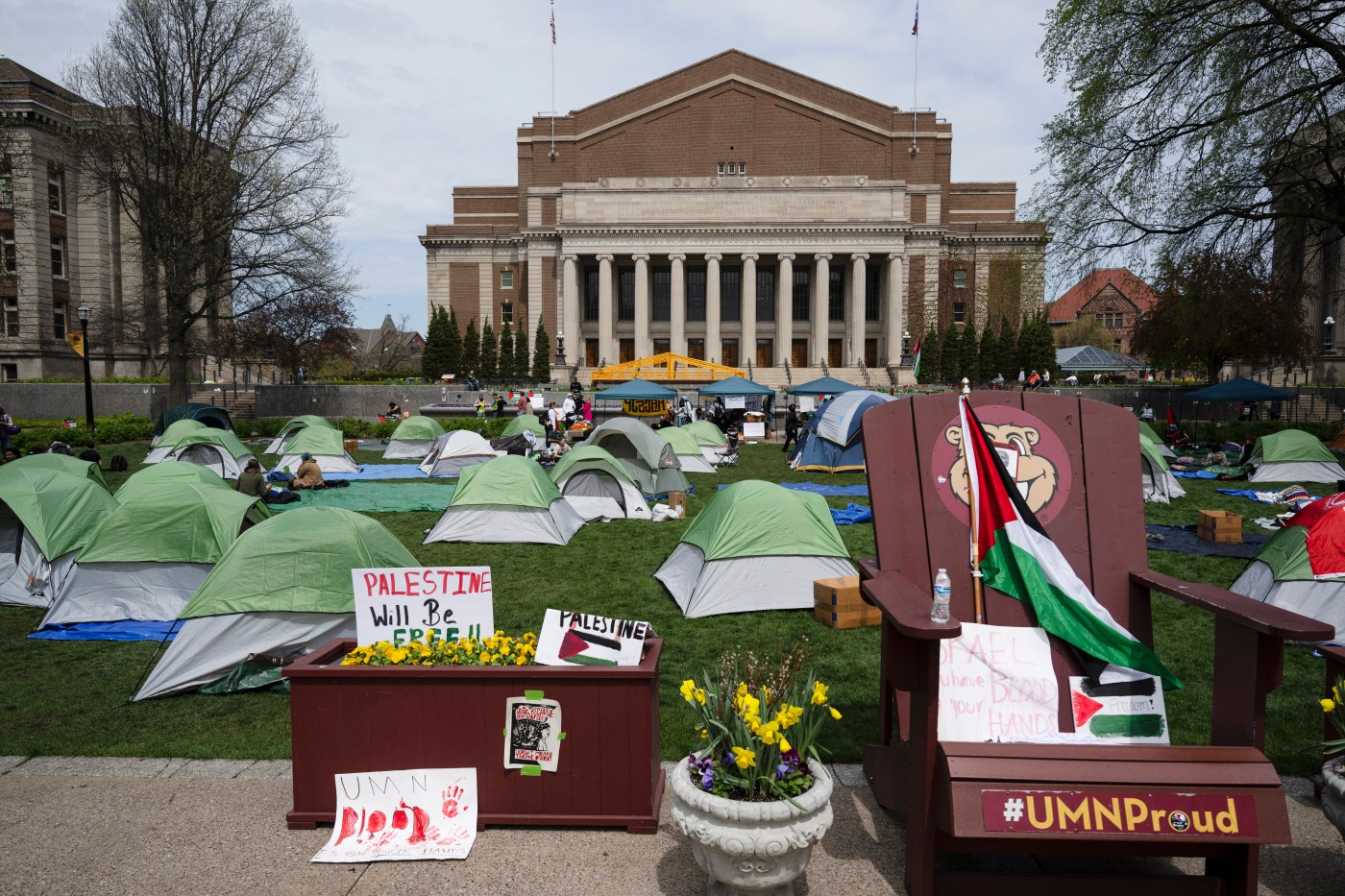
Thomas Friedman: Why the campus protests are so troubling
Readers have been asking me, and I have been asking myself of late, how I feel about the campus demonstrations to stop the war in the Gaza Strip. Anyone reading this column since Oct. 7 knows that my focus has been on events on the ground in the Middle East, but this phenomenon has become too big to ignore.
In short: I find the whole thing very troubling, because the dominant messages from the loudest voices and many placards reject important truths about how this latest Gaza war started and what will be required to bring it to a fair and sustainable conclusion.
My problem is not that the protests in general are “antisemitic” — I would not use that word to describe them, and indeed, I am deeply uncomfortable as a Jew with how the charge of antisemitism is thrown about on the Israel-Palestine issue. My problem is that I am a hardheaded pragmatist who lived in Beirut and Jerusalem, cares about people on all sides and knows one thing above all from my decades in the region: The only just and workable solution to this issue is two nation-states for two indigenous people.
If you are for that, whatever your religion, nationality or politics, you’re part of the solution. If you are not for that, you’re part of the problem.
And from everything I have read and watched, too many of these protests have become part of the problem — for three key reasons.
A free pass for Hamas
First, they are virtually all about stopping Israel’s shameful behavior in killing so many Palestinian civilians in its pursuit of Hamas fighters, while giving a free pass to Hamas’ shameful breaking of the cease-fire that existed on Oct. 7. On that morning, Hamas launched an invasion in which it killed Israeli parents in front of their children, children in front of their parents — documenting it on GoPro cameras — raped Israeli women and kidnapped or killed everyone they could get their hands on, from little kids to sick grandparents.
Again, you can be — and should be — appalled at Israel’s response: bombing everything in its path in Gaza so disproportionately that thousands of children have been killed, maimed and orphaned. But if you refuse to acknowledge what Hamas did to trigger this — not to justify what Israel has done, but to explain how the Jewish state could inflict so much suffering on Palestinian men, women and children in reverse — you’re just another partisan throwing another partisan log on the fire.
By giving Hamas a pass, the protests have put the onus on Israel to such a degree that its very existence is a target for some students, while Hamas’ murderous behavior is passed off as a praiseworthy adventure in decolonization.
‘From the river to the sea’
Second, when people chant slogans like “liberate Palestine” and “from the river to the sea,” they are essentially calling for the erasure of the state of Israel, not a two-state solution. They are arguing that the Jewish people have no right to self-determination or self-defense. I don’t believe that about Jews, and I don’t believe that about Palestinians. I believe in a two-state solution in which Israel, in return for security guarantees, withdraws from the West Bank, Gaza Strip and Arab areas of east Jerusalem, and a demilitarized Palestinian state that accepts the principle of two states for two people is established in those territories occupied in 1967.
I believe in that so strongly that the thing I am most proud of in my 45-year career is my interview with Saudi Crown Prince Abdullah bin Abdul Aziz, in February 2002, in which he, for the first time, called on the entire Arab League to offer full peace and normalization of relations with Israel in exchange for full withdrawal to the 1967 lines — a call that led the Arab League to hold a peace conference the next month, on March 27 and 28, in Beirut to do just that. It was called the Arab Peace Initiative.
And do you know what Hamas’ response was to that first pan-Arab peace initiative for a two-state solution? I’ll let CNN tell you. Here’s its report from Israel on the evening of March 27, 2002, right after the Arab League peace summit opened:
“NETANYA, Israel — A suicide bomber killed at least 19 people and injured 172 at a popular seaside hotel Wednesday, the start of the Jewish religious holiday of Passover. At least 48 of the injured were described as ‘severely wounded.’
“The bombing occurred in a crowded dining room at the Park Hotel, a coastal resort, during the traditional meal marking the start of Passover. … The Palestinian group Hamas, an Islamic fundamentalist group labeled a terrorist organization by the U.S. State Department, claimed responsibility for the attack.”
Yes, that was Hamas’ response to the Arab peace initiative of two nation-states for two people: blowing up a Passover Seder in Israel.
Hey, Friedman, some might ask, but what about all the violence that Israeli settlers perpetrated against Palestinians and how Bibi Netanyahu deliberately built up Hamas and undermined the Palestinian Authority, which embraced Oslo?
Answer: That violence and those Netanyahu actions are awful and harmful to a two-state solution as well. That is why I am intensely both anti-Hamas and anti-Netanyahu. And if you oppose just one and not also the other, you should reflect a little more on what you are shouting at your protest or your anti-protest. Because no one has done more to harm the prospects of a two-state solution than the codependent Hamas and Netanyahu factions.
Hamas is not against the post-1967 occupation. It is against the existence of a Jewish state and believes there should be an Islamic state between the river and the sea. When protests on college campuses ignore that, they are part of the problem. Just as much as Israel supporters who ignore the fact that the far-right members in Netanyahu’s own coalition government are for a Jewish state from the Jordan River to the Mediterranean Sea. How do I know? Because Netanyahu wrote it into the coalition agreement between himself and his far-right partners.
Palestinians who detest Hamas’ autocracy
The third reason that these protests have become part of the problem is that they ignore the view of many Palestinians in Gaza who detest Hamas’ autocracy. These Palestinians are enraged by precisely what these student demonstrations ignore: Hamas launched this war without permission from the population of Gaza and without preparation for them to protect themselves when Hamas knew that a brutal Israeli response would follow. In fact, a Hamas official said at the start of the war that its tunnels were for only its fighters, not civilians.
That is not to excuse Israel in the least for its excesses, but, again, it is also not to give Hamas a pass for inviting them.
My view: Hamas was ready to sacrifice thousands of civilians in Gaza to win the support of the next global generation on TikTok. And it worked. But one reason it worked was a lack of critical thinking by too many in that generation — the result of a campus culture that has become way too much about what to think and not how to think.
I highly recommend a few different articles about how angry Palestinians in Gaza are at Hamas for starting this war without any goal in mind other than the fruitless task of trying to destroy Israel so Hamas’ leader, Yehia Sinwar, could get his personal revenge.
I was particularly struck by a piece in The National, a newspaper in Abu Dhabi, by Ahmed Fouad Alkhatib, a Palestinian American raised in Gaza. The headline is: “Israel’s War Has Killed 31 Members of My Family, Yet It’s Vital to Speak Out Against Hamas.” Alkhatib placed Hamas’ Oct. 7 attack in the context of the rising protests against its inept and autocrat rule that have broken out periodically in Gaza since 2019, under the banner of “We Want to Live.”
Wrote Alkhatib, a political analyst who is a nonresident senior fellow at the Atlantic Council: “Having grown up in Gaza, I experienced Hamas’ rise to power and their gradual grip over the Strip and Palestinian politics and society, hiding behind a resistance narrative and using extremist politics to sabotage prospects for a peaceful resolution to the conflict with Israel. Months before Oct. 7, tens of thousands of Gazans protested in the streets in defiance of Hamas, just as they had in 2019 and 2017.”
Alkhatib added that the “‘We Want to Live’ protest movement decried living conditions and unemployment in Gaza, as well as the lack of a political horizon for meaningful change in the territory’s realities and opportunities. Hamas’ regime consisted of a criminal and despotic enterprise that used Gaza as a haven for the group’s members and affiliates and turned Palestinians there into aid-dependent subjects reliant on the international community” and turned Gaza into “a ‘resistance citadel’ that was part of a nefarious regional alliance with Iran.”
A campus with critical thinkers might have had a teach-in on the central lawn on that subject, not just on the violence of Israeli settlers.
Two indigenous peoples, two states
Against this backdrop, we are seeing college presidents at places like Rutgers and Northwestern agree to some of the demands by students to end their protests. As NPR summarized them, the “demands vary by school, though they generally call for an end to the Israel-Hamas war, disclosures of institutional investments and divestment from companies with ties to Israel or that otherwise profit from its military operation in Gaza.”
What Palestinians and Israelis need most now are not performative gestures of disinvestment but real gestures of impactful investment, not the threat of a deeper war in Rafah but a way to build more partners for peace. Invest in groups that promote Arab-Jewish understanding, like the Abraham Initiatives or the New Israel Fund. Invest in management skills capacity-building for Palestinians in the West Bank and Gaza, like the wonderful Education for Employment network or Anera, that will help a new generation to take over the Palestinian Authority and build strong, noncorrupt institutions to run a Palestinian state.
This is not a time for exclusionary thinking. It is a time for complexity thinking and pragmatic thinking: How do we get to two nation-states for two indigenous people? If you want to make a difference and not just make a point, stand for that, work for that, reject anyone who rejects it and give a hug to anyone who embraces it.
Thomas Friedman, born in Minneapolis and raised in St. Louis Park, writes a column for the New York Times.
Related Articles
Stephen Mihm: Comparing Gaza protests to the ’60s is wrong — and dangerous
Marc Champion: Don’t let Gaza help Iran cloak its own repression
Trudy Rubin: 2024 isn’t 1968: University protesters need more clarity about their goals
Thomas Friedman: Israel and Saudi Arabia are trading places
Jonathan Zimmerman: It’s ‘academic freedom’ when you agree but not when you don’t?


